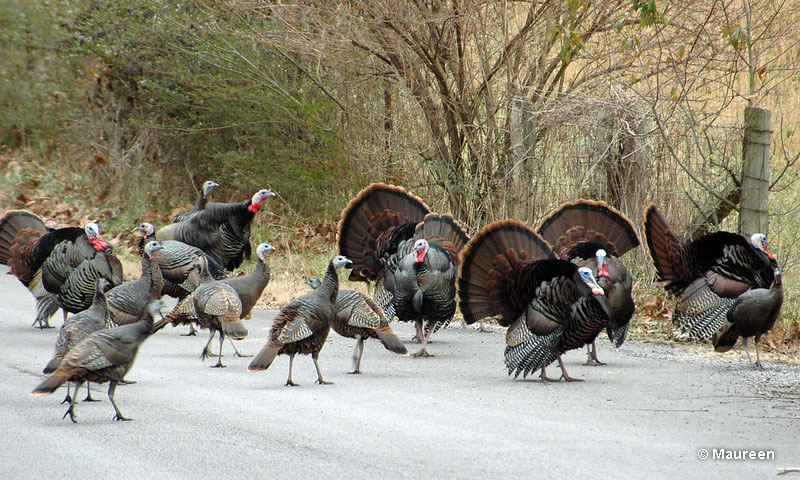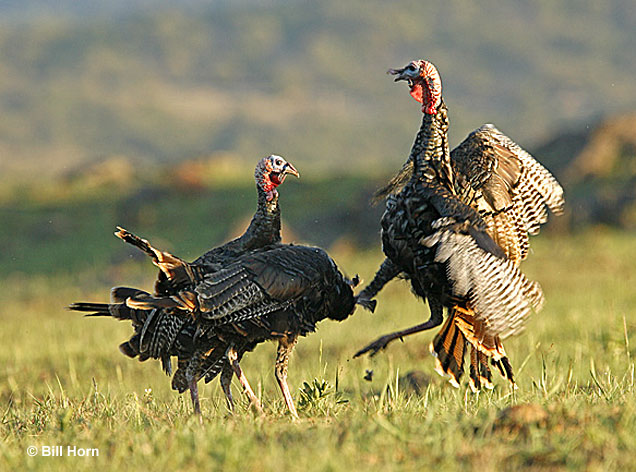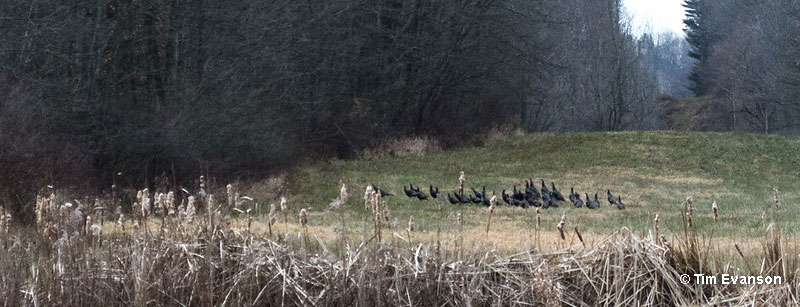
Turkeys are very social birds that flock together, especially in winter. During the winter months, in places where they are common, Wild Turkeys can form flocks of 40, 60, or even 200 birds, and in such situations, a group of Turkeys is simply known as a “flock.”
People have known about and remarked on the flocking behavior of Turkeys for as long as humans have interacted with them. With that in mind, it comes as no surprise that several terms have been used to refer to a group of Turkeys.
Did you know? The group nouns for birds come from medieval times and are not used for hundreds of years.
In captivity, a group of Turkeys are usually known as a “gaggle” or a rafter,” but groups of Turkeys have also been called a “dole,” a “run,” a “school,” a “raffle,” or even a “posse.”
These large, entertaining, and unique birds have come to be known by such a wide variety of names because they roost together in trees, have other, more complex flocking behaviors, and have been a very important domesticated animal for several centuries.
On this page
What is a Group of Turkeys Called?
A group of turkeys is most often referred to as a “flock,” but that’s usually reserved for Wild Turkeys. As with many other wild birds, the term flock is used to describe a group of birds that are foraging, flying, or just staying with each other.
Wild Turkeys are also sometimes known as “a run,” a word that references the tendency for these big birds to duck their heads and run into dense vegetation.
On the farm or in captivity, a group of turkeys isn’t usually called a “flock” but is instead referred to as a “gaggle” or a “rafter” of turkeys. Some people refer to Wild Turkeys as a gaggle because of certain behaviors the birds share with geese, another type of bird that also forms flocks and is also commonly held in captivity.
Like geese, turkeys are very social and vocal birds that make a variety of clucking sounds. Some of those vocalizations can sound like, “gah, gah” and this probably came into play when people first started referring to them as a gaggle. The other reason may have been simply because geese and turkeys were, and still are, often kept together on farms.
Why is it Called a Rafter of Turkeys?
Calling a group of turkeys a rafter may sound odd at first but the explanation makes complete sense.
In the wild, turkeys spend a lot of time on the ground foraging for food, displaying to impress mates, and are excellent and fast runners on the ground, but they never spend the night there.
To avoid nocturnal predators that could easily catch them, Wild Turkeys always fly up into trees to roost and sleep high above the ground all night long.
Domesticated turkeys have not lost this basic instinct and will fly or find their way up to a high place on the farm. In a barn, that perfect roosting spot happens to be wooden rafters up near the roof.
When a group of turkeys flies up to roost there, they can cover a rafter with their big, feather-covered bodies. It’s a sight to see, and this led to groups of turkeys on farms being commonly referred to as a rafter. While some folks may also call Wild Turkeys a rafter, this word is usually reserved for farm birds.
Some of the other, lesser-known terms to refer to a group of turkeys include:
- Gaggle
- Run
- Raffle
- School
- Dole
- Herd
- Gang – used for young male Turkeys that gang up on older, adult males.
- Crop – used for a new group of young turkeys.
- Brood – a group of Turkeys that includes the mother Turkey and her young.
- Posse – used for a group of young male Turkeys that seem to be up to no good.
- Death Row – used for Turkeys unknowingly waiting to be sacrificed for Thanksgiving (and Christmas dinners).
Why Do Turkeys Gather in Groups?
Turkeys are very social birds that spend much of the year in flocks with males in one flock and females forming another group. These flocks are situated near each other and intermingle in March and April, just before the breeding season.
As with many other birds and various other animals, including fish, mammals, and several insects, Wild Turkeys group together in flocks to protect themselves from predators.

For many animals and even people, it’s absolutely true that there is safety in numbers. The more eyes looking and the more ears listening, the more likely at least one individual will notice a predator and give the alarm.
If a bird in a flock of turkeys notices a Bobcat, Fox, or other predators before those animals can get close enough to pounce, stalking the group of turkeys is hardly worth their while.
Even though predators are looking for easy prey such as sick, old, or injured birds, if those individuals hear an early alarm, despite being at a disadvantage, they might still be able to reach safety in time.
Bobcats and many other predators much prefer the advantage of a surprise because it makes catching prey possible without using too much energy or risking injury. They much prefer to wait for an easier opportunity than a group of turkeys. Now, if a Wild Turkey gets separated from the flock and is on its own, that bird is much more susceptible to surprise and could become easy prey.
Turkeys also gather in groups to fight over dominance for breeding purposes, and to choose mates.
Frequently Asked Questions
Why is a flock of turkeys called a rafter?
A flock of turkeys is called a “rafter” because flocks of turkeys on farms have often roosted on rafters in barns.
What is a gaggle of turkeys?
A gaggle of turkeys is a name for a group of wild or domesticated turkeys making gobbling and clucking sounds.
Why do turkeys gobble?
Male turkeys gobble to attract and display to female turkeys during the breeding season.
Conclusion
A group of turkeys are most commonly known as a “flock (Wild Turkeys), or, in the case of domesticated birds, a “gaggle” or a “rafter”.
On account of their complex social behavior, tendency to flock together, and importance for people, groups of turkeys also go by several other names including “run”, “posse”, and even “death row”.
These fun birds flock together for protection from predators and other reasons. Thanks to protection and wise management, in some places, turkeys can be seen in groups of up to 200 birds.


